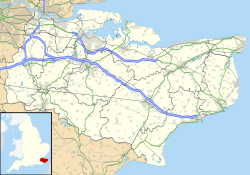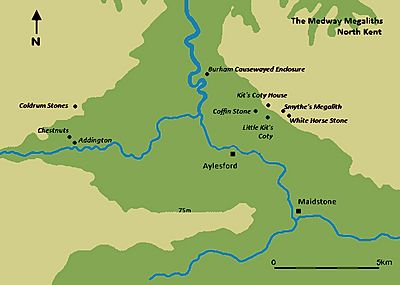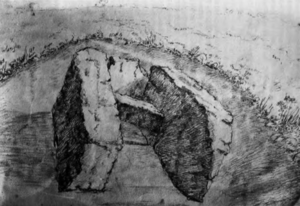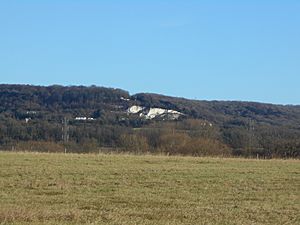Smythe's Megalith facts for kids

Clement Smythe's 1822 sketch of the chamber at Smythe's Megalith. It was destroyed the same day it was discovered.
|
|
| Coordinates | 51°19′N 0°31′E / 51.317°N 0.517°E (approx.) |
|---|---|
| Type | Long barrow |
Smythe's Megalith, also known as the Warren Farm Chamber, was an ancient burial mound. It was a type of tomb called a chambered long barrow. This monument was located near Aylesford in Kent, England.
It was likely built around 4000 to 3000 BCE. This was during Britain's Early Neolithic period, also known as the New Stone Age. Smythe's Megalith was found in 1822. Sadly, it was taken apart on the very day it was discovered.
The monument was made of earth and at least five large local stones called sarsen megaliths. It had a long, rectangular earth mound, called a tumulus. Inside its eastern end was a stone chamber. People placed human remains in this chamber.
Archaeologists believe that farming communities built this monument. This was shortly after farming arrived in Britain from Europe. Smythe's Megalith was part of a larger group of similar tombs. These are known as the Medway Megaliths. Several of these ancient sites still exist today. These include Coldrum Long Barrow, Addington Long Barrow, and Chestnuts Long Barrow. Others are Kit's Coty House, the Little Kit's Coty House, and the Coffin Stone.
The site might have been disturbed in the Middle Ages. By the early 1800s, it was buried under soil. This was due to soil washing down from nearby Blue Bell Hill. In 1822, farm workers found it while ploughing. Local experts, Clement Smythe and Thomas Charles, came to study it. Soon after, the workers removed the stones. They also scattered most of the human remains. This destroyed the monument. Smythe and Charles wrote reports about their findings. These reports have helped archaeologists understand the site since the mid-1900s.
Contents
Where Was Smythe's Megalith Located?
Smythe's Megalith was found on the lower slope of Blue Bell Hill. This is near Warren Farm, close to Aylesford in Kent, England. The exact spot is now in a large field. It is east of the A229 road.
Today, you cannot see any part of the monument. The specific location is also not open to the public.
What Was Life Like in the Early Neolithic Period?
The Early Neolithic period was a time of big changes in Britain. Between 4500 and 3800 BCE, people's lives changed a lot. Communities in the British Isles started farming. They stopped being hunter-gatherers. This new way of life came from societies in continental Europe.
Britain was mostly covered in forests back then. Large-scale forest clearing did not happen in Kent until much later. This was during the Late Bronze Age (around 1000 to 700 BCE). Evidence from nearby areas shows that the land was still heavily forested. It had trees like oak, ash, and hazel.
Archaeologists think that the economy was mostly based on herding cattle. People probably moved around a lot. They lived a nomadic or semi-nomadic life. There is little evidence of permanent homes from this time.
Understanding the Medway Megaliths
In Western Europe, the Early Neolithic was when people first built huge structures. These included chambered long barrows. These were rectangular or oval earth mounds. They had a chamber built into one end. Some chambers were made of wood. Others used very large stones, called "megaliths."
Long barrows often served as tombs. They held the remains of the dead. People were usually buried together in these tombs. This showed they were part of a community. These stone tombs were built along the coast of Western Europe. They stretched from Spain to Sweden. This building style came to Britain around 4000 to 3000 BCE.
The Medway Megaliths were some of the biggest monuments in Britain. They were built along the River Medway. They are the most southeastern group of megalithic sites in the British Isles. They are also the only group in eastern England.
Archaeologists consider them very important. They are described as "some of the most interesting and well known" sites in Kent. They are also called "the most impressive structures of their kind in southern England."
The megaliths are in two main groups. One is west of the River Medway. The other is on Blue Bell Hill to the east. The western group includes Coldrum Long Barrow, Addington Long Barrow, and the Chestnuts Long Barrow. The eastern group has Smythe's Megalith, Kit's Coty House, Little Kit's Coty House, and the Coffin Stone. We don't know if they were all built at the same time. We also don't know if they had the same purpose.
All the Medway long barrows followed a similar plan. They were all lined up from east to west. Each had a stone chamber at its eastern end. They likely had a stone front at the entrance. The chambers were built from sarsen stone. This is a very hard and strong stone. It is found naturally in Kent. Builders would have chosen stones from the local area. Then they moved them to the building site.
These shared features show that the Medway Megaliths were unique to their region. They were taller than most other long barrows in Britain. Some were up to 3.8 meters (10 feet) high. However, there were also differences between them. For example, Coldrum had a straight shape. Chestnuts Long Barrow had a special front. These differences might mean the monuments were changed over time.
Archaeologists think the builders were influenced by older tomb designs. We don't know if these people were from the Medway area. Or if they moved there from somewhere else. Experts have different ideas about where the design came from. Some think it was from the Low Countries. Others suggest Scandinavia or Germany. It is hard to say for sure where the exact origin was.
How Was Smythe's Megalith Built?
The part of Smythe's Megalith that was found was a stone chamber. It was made of four large sarsen stones. The northern stone was about 2.3 meters (7.5 feet) long. The southern stone was about 2.1 meters (7 feet) long. A third stone was on the western side. A fourth, smaller stone was placed to support the northern stone. This smaller stone might have divided the chamber in two.
Based on the stone sizes, the chamber might have been 6 meters (20 feet) long. It could have used up to ten sarsen stones. It might have been about 1.2 meters (4 feet) high. This would make it one of the smaller chambers in the Medway area. For example, the chamber at Kit's Coty House was over 1.8 meters (6 feet) high.
Below these large stones was a flat stone. It was about 1.2 meters (4 feet) long and 0.9 meters (3 feet) wide. Human remains were found on top of this stone. They were reportedly lined up from east to west. This flat stone might have been a cover stone. It could have fallen down at some point. If so, the bones would have been moved from their original spot. A mole's skull was also found near the bones.
A small piece of plain pottery was found with the bones. This pottery might not be from when the tomb was first built. Other similar tombs stayed open for hundreds or thousands of years. During that time, other things could have been placed inside. For example, pottery from the Late Neolithic period was found at Kit's Coty House. The pottery at Smythe's Megalith might also be from this later time.
When the site was found, there was no clear mound. This was partly because soil had built up over thousands of years. But we know from other sites that this stone chamber was at the eastern end of a long earth mound. This mound could have been up to 55 meters (180 feet) long. It might have had stones lining its sides. This is seen at other Medway Megaliths. The monument might also have had ditches along its sides. Chalk from these ditches could have been used to build the mound.
During the Early Neolithic, other tombs might have been nearby. The White Horse Stone is close by. It might have been part of another long barrow. Other sarsen stones have been found in the area. These could be parts of other destroyed long barrows.
Archaeologists found an Early Neolithic building near the White Horse Stone. It was about 18 meters (59 feet) long and 8 meters (26 feet) wide. This was a type of longhouse found across Europe. If it was a home, only a small family would have lived there. A smaller, round building was also found nearby. These buildings might have been "houses of the living." They could have been visible from the "houses of the dead," like Smythe's Megalith. Or, the longhouse might have been used for funeral activities. This could include preparing the dead or holding feasts.
Human Remains Found
Bones found in the chamber were studied in the 1820s. Most of the bones were broken into small pieces. This was probably caused by the workers who found them. The bones included pieces of skull, ribs, and limb bones. There were parts of two jawbones. This showed that at least two people were buried there. The teeth were worn down and flat. This meant the people were middle-aged when they died.
What Happened to the Site Later?
Later, a settlement was built about 200 meters (656 feet) from the Neolithic houses. This was during the Late Bronze Age and Iron Age. It had several round houses and deep pits. These pits might have stored grain. Later, they were filled with pottery, iron objects, animal bones, and two human burials. Archaeologists think these items were not just trash. They might have been placed there as part of a special ceremony.
Some experts think the tomb was still visible in the Middle Ages. They believe it might have been damaged by people digging into it. For example, Chestnuts Long Barrow was damaged in the 12th or 13th centuries. Similar damage has been seen at other Medway Megaliths. This damage might have been caused by people trying to destroy old, non-Christian monuments.
Another idea is that medieval treasure hunters robbed the site. There are records of barrows being opened for treasure in other parts of England. This might have happened in Kent too. Some think the damage was done by a special group. This is because the robbery was very thorough. It would have needed more resources than a local community had.
How Was Smythe's Megalith Discovered?
In 1822, workers were ploughing a field at Warren Farm. Their ploughs kept hitting stones underground. They removed the topsoil and found three large stones. The farm owner, George Fowle, called in two men from Maidstone. These were Clement Taylor Smythe, a historian, and Thomas Charles, a doctor.
Smythe was there when the workers removed soil around the stones. They found a smaller fourth stone. Smythe realized it looked like the nearby Kit's Coty House. The stones were then removed, probably with horses. This destroyed what was left of the monument.
The next day, the workers dug deeper. They found a flat stone with human remains. Smythe was not there that day. The workers threw most of the bones aside. But Smythe collected some. These were later studied by Charles.
Reports About the Discovery
A short article about the discovery appeared in the Maidstone Journal in July 1822. This information was repeated in the Gentleman's Magazine later that year. The Gentleman's Magazine wondered who the buried people were. It suggested they might be "some chief slain in the battle fought here."
About a year after the discovery, Smythe wrote a report. It included a sketch and a plan of the chamber. Smythe's report was not published at the time. It was kept in the archives of Maidstone Museum. In this report, he called the monument a "British Tomb." This document was finally published in 1948. It appeared in an article by archaeologist John H. Evans. Evans said that even though the report was short, it was very valuable. He noted that many ancient sites were destroyed back then. So, these early records were very important.
A second short report was also put in the museum. It was probably written by Charles. This was also published in 1948. An archaeologist named Paul Ashbee later said both reports were "brief but valuable." He thought they were "in many ways in advance of their age." He stressed that these records were important. They were written before the study of prehistory became a proper field.
In the 1920s, archaeologist O. G. S. Crawford looked at the museum archives. He wanted to find the likely spot of Smythe's Megalith. He then included the site in his 1924 guide to archaeological sites. In 1955, more large stones were found in the area. In 2000, Ashbee said some of the lining stones had "recently come to light." They were found buried in the monument's ditches.








